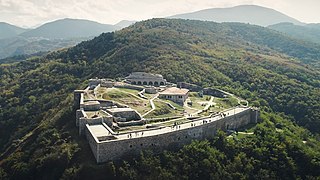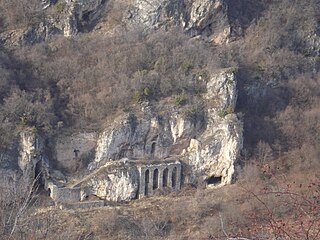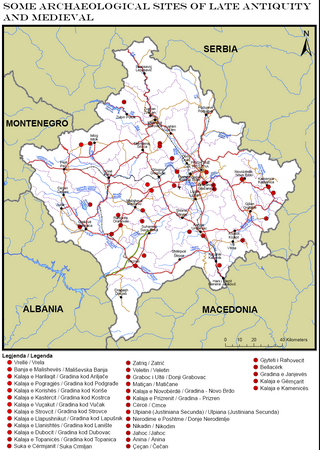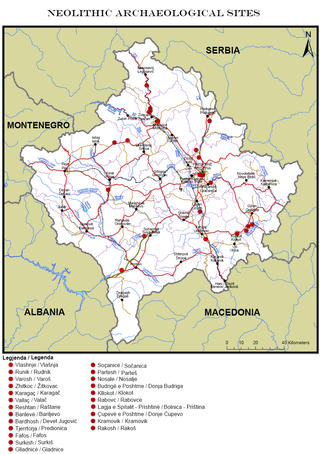
Prizren is the second most populous city and municipality of Kosovo and seat of the eponymous municipality and district. It is located on the banks of the Prizren River between the foothills of the Sharr Mountains in southern Kosovo. Prizren experiences an oceanic climate under the influence of the surrounding mountains.
The Monastery of St. Mark of Koriša was a Serbian Orthodox monastery built in 1467, located in Korishë, Prizren, Kosovo. The entire complex was declared a Protected Monument of Culture in 1959, and it is de jure protected by Republic of Serbia. It was a single-nave church, built on a rectangular foundation. It was severely damaged after the end of the Kosovo War in 1999.

The Fortress of Zvečan, also known as Zvečan/Zveçan medieval fortress and Fortress of Mitrovica, located in the northwest of the city of North Mitrovica, in Kosovo, is an enormous castle and one of the oldest fortresses in Southeastern Europe. It was built on the top of the extinct volcano vent, overlooking the Ibar river. Zvečan Fortress was declared Monument of Culture of Exceptional Importance in 1990, and it was protected by the Republic of Serbia.

Prizren Fortress is a hilltop fortification in Prizren in Kosovo. It overlooks the Prizren River which flows through Prizren, which developed around the fortress. The site of the fortress of Prizren has seen habitation and use since the Bronze Age. In late antiquity it was part of the defensive fortification system in western Dardania and was reconstructed in the era of eastern Roman Emperor Justinian. Byzantine rule in the region ended definitively in 1219–20 as the Serbian Nemanjić dynasty controlled the fort until 1371.
The archaeological heritage of Sri Lanka can be divided into three ages; Prehistoric (Stone-age), Protohistoric, and historical period. The presence of man activities in Sri Lanka probably dates from 75,000 years ago. Prehistoric sites which are presently identified in the country are distributed from the maritime belt and the lowland plains of the wet and dry zones to the high plateaus and rain forests in the central and southwestern mountain regions of the island. The protohistoric period expands from about 1000 BC to the historical period at about 500 BC. The main indicators of the distribution of protohistoric and early settlements on the island are the megalithic burials and pottery sites.

The Hermitage and Monastery of Saint Peter Koriški is a ruin of the hermitage and monastery located in Koriša, Prizren municipality, Kosovo. The monastery and hermitage are on the same location.

The LoDaisKa site is a prominent archaeological site in the U.S. state of Colorado, located within a rockshelter near Morrison. The rockshelter was first inhabited by people of the Archaic through the Middle Ceramic period, generally spanning 3000 BC to 1000 AD.

Franktown Cave is located 25 miles (40 km) south of Denver, Colorado on the north edge of the Palmer Divide. It is the largest rock shelter documented on the Palmer Divide, which contains artifacts from many prehistoric cultures. Prehistoric hunter-gatherers occupied Franktown Cave intermittently for 8,000 years beginning about 6400 BC The site held remarkable lithic and ceramic artifacts, but it is better known for its perishable artifacts, including animal hides, wood, fiber and corn. Material goods were produced for their comfort, task-simplification and religious celebration. There is evidence of the site being a campsite or dwelling as recently as AD 1725.

Archaeology of Kosovo as a field of study and research was started in the second half of the 20th century. Kosovo's field of archaeology has developed in tandem with the historical study, studies of ancient authors' sources, classic philological studies, theological data research, topographic studies and ground survey, analysis of toponyms, deciphering of epigraphic and historiographic data. First data about antique monuments in Kosovo, were documented from the end of the 19th until the beginning of the Second World War, a time period when Kosovo was visited by researchers, guides, and archaeologists such as: Evans, Boue, Hahn, Kanitz, Tomaschek, Domaschevski, Arpad, Vulic, Jirecek, Patsch, Domenico Mustilli, etc.

Part of series of articles upon Archaeology of Kosovo

This is a description of Neolithic sites in Kosovo. The warm, humid climate of the Holocene which came soon after the ice melting of the last glacial period brought changes in nature which were reflected in humans, flora and fauna. This climatic stabilization influenced human life and activities; human society is characterized by changes in community organization and the establishment of permanent settlements in dry places, near riverbanks and on fertile plateaus.
Part of series of articles upon Archaeology of Kosovo
Monuments of Kosovo comprise all the monuments that are located in Kosovo.

The Harilaq Fortress is a hilltop fortification west of the village of Harilaq in Kosovo. The fortress is of great archaeological importance, with its roots tracing back to prehistoric times and its peak development occurring during late Antiquity through the early Byzantine period.
Vlashnjë is a village in the Prizren municipality of Kosovo. It has 1,700 inhabitants as of 2011. Vlashnjë is a multi-layered settlement and site area. Archaeological excavations have identified habitation and use of the area since the Neolithic era. The rock art paintings at Mrrizi i Kobajës are the first find of prehistoric rock art in Kosovo. In late antiquity, Vlashnja was a fortified settlement part of the fortification network which Justinian I rebuilt along the White Drin in Dardania.
Mitrovica is one of the oldest settlements in Kosovo and a very important urban ensemble. There are many traces which have special interest and prove early civilization of the territory of Mitrovica, in particular from the Illyrian inhabitation in antiquity.
The strategic position of the region of Mitrovica in the middle of two great rivers Ibar and Sitnica and its mineral wealth in Albanik, made this location populated since prehistoric period. This region was populated by Illyrians, respectively members of the Dardan tribe. The first data for the archaeological sites in the region of Mitrovica, begin with the researches of Sir Artur John Evans, who was the first to pinpoint the Roman town of the Municipium Dardanourm. In the archaeological sites of the region of Mitrovica were found traces and objects from different periods such as; Neolithic, Roman, late antiquity and medieval period. Objects and figurines include: fortress vestiges, necropolis, Terpsichore figure, statues, sarcophagus, altar, jewelry, etc.
Kosovo has a rich heritage in archaeology, however the field suffers from a lack of substantial institutional research. Since prehistory, the advantageous geostrategic position and abundant natural resources of the area have been suitable for the emergence of life. This is shown by the traces of hundreds of archaeological sites discovered throughout the country, displaying the abundant archaeological legacy.
The architecture of Kosovo dates back to the Neolithic period and includes the Copper, Bronze and Iron Ages, Antiquity and the Medieval period. It has been influenced by the presence of different civilizations and religions as evidenced by the structures which have survived to this day. Local builders have combined building techniques of conquering empires with the materials at hand and the existing conditions to develop their own varieties of dwellings.

The Dardana Fortress is an archaeological site of the Bronze Age, Iron Age and late antiquity in present-day eastern Kosovo. It is located on a hill to the northwest of Kamenica. It was a hilltop settlement and fortress of the Dardani in classical antiquity. It was rebuilt in the late Roman period as part of the fortification system in the Roman province of Dardania. The site was discovered in the 1970s, but excavations did not start in earnest until 2012. One of the very earliest finds at the site is a funerary stele found accidentally at the foot of the hill in 1992. Its interpretation has helped shed light on Illyrian burial customs, and excavations at the site have contributed to knowledge about the trade patterns between Dardania and the Mediterranean region. Similar sites have been discovered in recent years in the Kamenica region.










